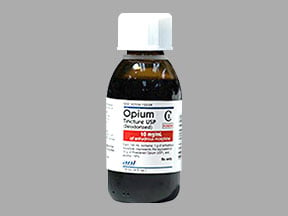
Opium Coupons & Savings Card – Discount Prices from $183.96
My prescription
Edit
118ML of 10 MG/ML(1%), Opium (1 Bottle)
Select pharmacy

CVS
$217.23
COUPON PRICE
Walgreens
$183.96
COUPON PRICE
Albertsons
$378.89
COUPON PRICE
Walmart
$669.50
COUPON PRICEFree Opium Savings Card

Walgreens
$183.96
Show this coupon to your pharmacist
ID
LHET726322
PCN
GDC
BIN
015995
GRP
GDRX
This coupon is not insurance
Related opioids prescriptions
More prescriptions for diarrhea
Related opioids prescriptions
More prescriptions for diarrhea
Opium dosage forms
Dosage Quantity Price from Per unit 118ML of 10 MG/ML(1%) 1 Bottle $230.52 $230.52 118ML of 10 MG/ML(1%) 2 Bottles $443.04 $221.52 118ML of 10 MG/ML(1%) 3 Bottles $655.55 $218.52
| Dosage | Quantity | Price from | Per unit |
|---|---|---|---|
| 118ML of 10 MG/ML(1%) | 1 Bottle | $230.52 | $230.52 |
| 118ML of 10 MG/ML(1%) | 2 Bottles | $443.04 | $221.52 |
| 118ML of 10 MG/ML(1%) | 3 Bottles | $655.55 | $218.52 |
Opium Warnings
This information provides crucial safety guidelines regarding the use of opium tincture. It is essential to adhere to these instructions and consult your healthcare provider if you have any questions or concerns.
Risk of Addiction and Misuse: Opium tincture is classified as a Schedule II controlled substance due to its potential for addiction and misuse. It is vital to take the medication precisely as prescribed and not alter the dosage or frequency without consulting your healthcare provider. Misuse can reduce the effectiveness of the medication and increase the risk of severe side effects, including dangerously slow breathing and possible opioid overdose. Individuals with a personal or family history of alcohol or substance use disorder or mental health issues are at increased risk.
Opioid Overdose Risks: Follow your prescription carefully to prevent accidental overdoses. Signs of an opioid overdose include unresponsiveness to sound or touch, severely slowed breathing, drowsiness, slow heartbeat, and cold or clammy skin. It is crucial for you and those around you to recognize these symptoms. Your healthcare provider might suggest keeping naloxone (Narcan, Zimhi) nearby as it can counteract an opioid overdose. Always carry naloxone and call emergency services immediately if an overdose occurs. Keep the medication out of reach of children, pets, or visitors to prevent accidental consumption. Higher risk is associated with a history of opioid use disorder, previous overdoses, high doses of opium tincture, exceeding prescribed doses, and alcohol consumption.
Physical Dependence and Withdrawal: Opium tincture should be used sparingly for diarrhea management. Prolonged regular use can lead to physical dependence, where the body becomes reliant on the medication. Abrupt cessation can result in withdrawal symptoms such as anxiety, restlessness, irritability, runny nose, yawning, sweating, and chills. Discuss alternatives with your healthcare provider if concerned about these risks, especially with long-term use.
Risks to Newborns: Pregnant individuals should be aware that opium tincture can cross the placenta, potentially causing dependence in the unborn child. After birth, the baby might exhibit withdrawal symptoms like high-pitched crying, poor feeding, trembling, abnormal sleep patterns, and seizures. This condition, known as neonatal opioid withdrawal syndrome, can be life-threatening if untreated. Inform healthcare professionals if you have used opium tincture during pregnancy or if such symptoms are observed in your newborn.
Contraindications:
Children: This medication should not be used in children.
Poison-Induced Diarrhea: Avoid use in cases of diarrhea caused by poison until the toxin is eliminated from the body.
These guidelines are vital for the safe and effective use of opium tincture. Always consult your healthcare provider for personalized advice.
Opium Side Effects
Common side effects:
- nausea
- vomiting
- lightheadedness
- dizziness
- drowsiness
- constipation
Less common but important to monitor:
- mental or mood changes like agitation
- confusion
- hallucinations
- severe stomach or abdominal pain
- difficulty urinating
Serious side effects:
- fainting
- seizures
- slow or shallow breathing
- severe drowsiness or difficulty waking up
- allergic reaction symptoms such as rash, itching, swelling, severe dizziness, and trouble breathing
Opium Interactions
Interactions with high risk of serious adverse effects and should be avoided:
- Nalmefene
- Naltrexone
- Safinamide
Interactions with moderate risk that may require dose adjustment, closer monitoring, or timing changes:
- Alfentanil
- Alprazolam
- Amphetamine
- Benzhydrocodone
- Benzphetamine
- Bromazepam
- Bromopride
- Buprenorphine
- Butorphanol
- Calcium Oxybate
- Cannabidiol
- Carbinoxamine
- Cetirizine
- Clobazam
- Clopidogrel
- Codeine
- Desmopressin
- Desvenlafaxine
- Dextroamphetamine
- Dihydrocodeine
- Doxylamine
- Duloxetine
- Escitalopram
- Esketamine
- Fenfluramine
- Fentanyl
- Flibanserin
- Gabapentin
- GabapentinEnacarbil
- Granisetron
- Hydrocodone
- Hydromorphone
- Ketamine
- Lasmiditan
- Lemborexant
- Levocetirizine
- Levorphanol
- Lisdexamfetamine
- Lithium
- Lofexidine
- Lorazepam
- Loxapine
- Magnesium Oxybate
- Meclizine
- Meperidine
- Metaxalone
- Methadone
- Methamphetamine
- Metoclopramide
- Midazolam
- Mirtazapine
- Morphine
- MorphineSulfate Liposome
- Nalbuphine
- Ondansetron
- Oxycodone
- Oxymorphone
- Ozanimod
- Pentazocine
- Periciazine
- Potassium Oxybate
- Pregabalin
- Remifentanil
- Remimazolam
- Scopolamine
- Sertraline
- Sodium Oxybate
- Sufentanil
- Tapentadol
- Tramadol
- Trazodone
- Vortioxetine
- Zolpidem
